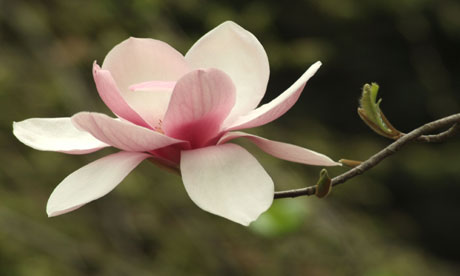
In the pink: sun-loving Magnolia grandiflora in bloom. Photograph: shapencolour/Alamy
On a bright day in February, with the grip of winter still upon us, I noticed that a silent shift had happened in the front gardens. The magnolia buds were swelling, the buds standing proud and silvered in the branches with their downy cases catching the sunlight. Just a week before I had passed the same trees and stopped more than once that day to ponder the value they bring in pure expectation.
Magnolias are some of the most primitive of our flowering trees, and fossils dating back millennia prove that they have had little need to evolve. I like the thought of them unchanged and illuminating darkly primitive forests, but their adaptability has also made them the subject of many a nurseryman's obsession. Today we are spoiled by a magnolia lovers' legacy of selection and breeding, for they make good garden plants, from neatly behaved bushes to the grandest of flowering trees.
They are worthy of investment and most are happy in a range of conditions and will thrive in sun and flower more heavily there if given shelter. Most importantly, they will mark the time of year like clockwork when they bless you with flower.
Despite their natural forest habitat, the majority are perfectly happy to adapt to city living. The fleshy tones of Magnolia x soulangeana have become a signature of a certain period of town garden and the trees we see emblazoning front gardens are as old as our grandparents. Although I am always pleased to see their return in March, this sugary hybrid suffers from its own success and I have never planted one. Why do that when you could dip into such an extensive list of reliable cultivars?
In warmer parts of the country the tree magnolias have been blooming since February. I first came upon Magnolia campbellii as a student at Wisley. Once seen, never forgotten. You need not only room but also time on your side if you are to plant one, because they can take 15 to 20 years to flower. The flowers emerge from primitive buds which stand bolt upright in lofty branches and the bud casing is felted brown or gold and breaks open to reveal a cerise pink bud. This opens over the course of a day to expand into an open goblet the width of your two hands placed palm to palm, your fingers extended.
I prefer to opt for the hybrids which combine the drama of this parent, but include the genes for trees which are more modestly sized and bloom at an earlier age.
"Atlas" has perhaps the largest flowers of all and they need a sheltered spot if they are not to be torn to shreds by a March wind. Of the large-flowered hybrids those with flowers are better designed to cope with the vagaries of our weather. There's moody "Iolanthe", with dark mauve flowers bleeding deeper at the base of the petals; "Vulcan" and "Felix Jury", with cerise pink goblets and an eagerness to flower young. "David Clulow" is perhaps the best of this group and arguably of all the all-white magnolias for purity, form and poise in that window of life while blossoming trees are still alone and leaves are yet to break in the trees.
Adaptable to a range of conditions are the Magnolia x loebneri crosses. Magnolia x loebneri "Pirouette" retains the stellata in a neat, well-behaved form ideal for the smaller garden while "Merrill" has larger flowers, loosely formed and the ability to equal the size of an old apple in stature. "Leonard Messel" has flowers twisted dark sugary pink on the outside with a paler pink inside. They are spicily scented and more than happy in an exposed position. Though most magnolias prefer a soil on the acid side of neutral, M loebneri is adaptable to a limey soil.
A frost pocket is the worst situation for the spring-blooming magnolias so grow them where the frost doesn't linger or on the west side of a building where early-morning sun won't thaw buds quickly. This can be lethal and one of the few things to blight an otherwise reliably wonderful race of beauties.
Get growing
Grow the later-blooming summer-flowering magnolia, such as M x weisneri and the sun-loving M grandiflora if you suffer from frost but still want to bask in their glory